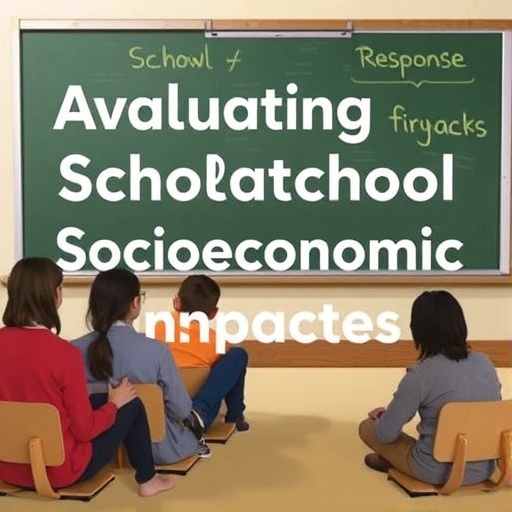In recent years, the discourse surrounding the socioeconomic composition of schools has gained traction in the field of educational research, particularly concerning its implications for student outcomes. Michael G. Sciffer’s insights delve deeper into this critical issue, exploring the ways in which the socioeconomic environment of schools influences educational achievement and learning dynamics. The article titled “The substantiveness of school socioeconomic compositional effects: a response to Marks,” published in the 2024 volume of Large-scale Assess Educ, stands as a significant contribution to ongoing discussions in this domain.
The socioeconomic composition of a school—essentially a reflection of the economic backgrounds of its students—has emerged as a pivotal determinant of educational success. Sciffer argues that the extent to which a school’s environment can either buffer against or exacerbate socioeconomic disadvantages is profound. He asserts that simply acknowledging the socioeconomic status (SES) of students is insufficient for capturing the complexities of educational outcomes. Instead, a nuanced understanding of how these compositional effects operate within the school context is essential for developing effective interventions.
One key argument made in Sciffer’s work is that the effects of socioeconomic composition extend far beyond mere averages; they are substantially intertwined with the specific educational practices and policies implemented at schools. In essence, a comprehensive approach to education policy must take into account the multifaceted interactions between students’ backgrounds and the institutional responses of schools. This theoretical framework challenges the oft-held belief that the socioeconomic mix of a school solely dictates student performance, suggesting a more complex interplay exists.
Moreover, Sciffer critiques existing metrics that quantify school effectiveness, particularly those that disregard the nuances of socioeconomic composition. He emphasizes that many current educational assessments fail to capture the depth of varying influences, rendering a simplistic analysis of performance data that can lead to misguided policy decisions. Schools situated in lower SES areas may, through innovative practices or community engagement, achieve remarkable outcomes that assessment tools fail to recognize.
The research draws upon a multitude of case studies and quantitative analyses to underscore the variability of socioeconomic effects across different contexts. By meticulously examining examples from diverse educational environments, Sciffer elucidates the mechanisms through which socioeconomic disparities manifest in academic performance. His analysis reveals patterns that suggest schools can effectively bridge socio-economic divides by implementing contextually appropriate strategies aimed at enhancing student engagement and achievement.
Furthermore, the discussion in Sciffer’s article also incorporates the broader implications of socioeconomic composition on student identity and peer relationships within schools. He posits that students from varied backgrounds benefit not just academically but socially from diverse peer interactions. Ultimately, this diversity fosters a richer educational experience that can cultivate empathy, resilience, and adaptability among students.
In responding to Marks, Sciffer does not merely critique opposing viewpoints; he also articulates a vision for future educational frameworks that prioritize inclusivity and nuance. He advocates for policies that are informed by research showing that schools invoking a robust understanding of their student composition can tailor their practices to address vulnerabilities faced by lower SES students while maximizing the potential of all learners.
Educational leaders and policymakers are urged to reconsider the design and execution of programs intended to alleviate the effects of socioeconomic disadvantage. Sciffer highlights the need for transparency in data reporting, improving the dialogue surrounding educational equity. He argues that addressing inequities requires a concerted effort from all stakeholders in education, emphasizing collaboration between schools, communities, and policymakers.
Another critical aspect of Sciffer’s response is his reflection on the importance of professional development for educators. Teachers, armed with a deeper understanding of the socioeconomic dynamics present in their classrooms, can implement more tailored instructional strategies. This emphasis on professional growth is crucial for fostering a responsive and adaptive teaching workforce that can meet the diverse needs of their students.
Addressing potential criticisms of his approach, Sciffer acknowledges that while socioeconomic composition plays a significant role, it does not occur in isolation. Variables such as school funding, teacher quality, and community resources also significantly influence educational outcomes. His nuanced perspective serves as a reminder that while it is essential to consider socioeconomic composition, it is equally crucial to adopt a holistic view of all factors impacting student success.
In conclusion, Sciffer’s article represents an important step forward in understanding the complexities of school socioeconomic composition and its effects on education. As the debate continues, his findings provide a solid foundation for developing policies that genuinely address the needs of diverse populations in educational settings. For stakeholders in education, including administrators, teachers, and policymakers, engaging with these substantial insights holds the potential to reshape future educational practices in a way that champions equity, fosters student success, and enriches the learning environment for all.
As we move forward, the implications of Sciffer’s work call for a revamped dialogue around education that prioritizes not only data-driven outcomes but also the lived experiences of students from all socio-economic backgrounds. His findings challenge the status quo, inspiring educators and policy-makers alike to consider not just the “how” of education, but importantly, the “who” and “where,” urging a compassionate exploration of the contexts in which learning takes place.
In making these connections clear, Sciffer not only addresses current complexities in educational systems but also outlines a vision for an informed and empathetic approach to addressing socioeconomic diversity in schools.
By engaging in these critical conversations, stakeholders have an opportunity to effect meaningful change. Sciffer’s dedication to elaborating on the substantive effects of socioeconomic composition in education highlights not just a theoretical framework but also a call to action that resonates with all who envision a more equitable future for education.
Subject of Research: Socioeconomic compositional effects in education
Article Title: The substantiveness of school socioeconomic compositional effects: a response to Marks
Article References: Sciffer, M.G. The substantiveness of school socioeconomic compositional effects: a response to Marks. Large-scale Assess Educ 12, 35 (2024). https://doi.org/10.1186/s40536-024-00223-w
Image Credits: AI Generated
DOI: 10.1186/s40536-024-00223-w
Keywords: socioeconomic composition, educational outcomes, school policies, educational equity, student engagement




